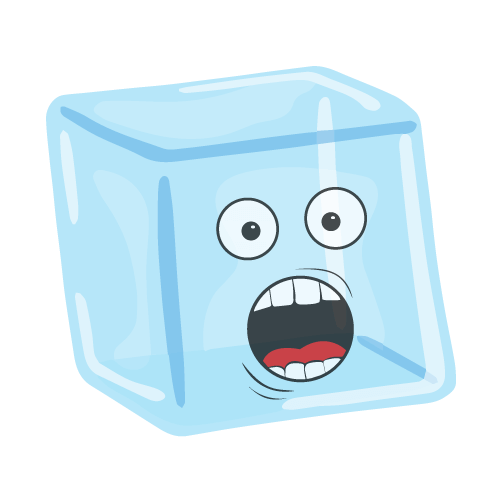School activities allow both students and teachers to make the educational process in and out of the classroom entertaining and engaging. They also help students get reacquainted with each other or meet new friends at the beginning of the school year, break the monotony in the classroom, and do something different than the regular activities they engage in.
Yet, with so many such activities out there, it’s understandable that it can sometimes get overwhelming to make a choice.
We’re here to help you with our detailed list of 15 school activities for teachers and students, so let’s get into it.
Benefits of School Activities
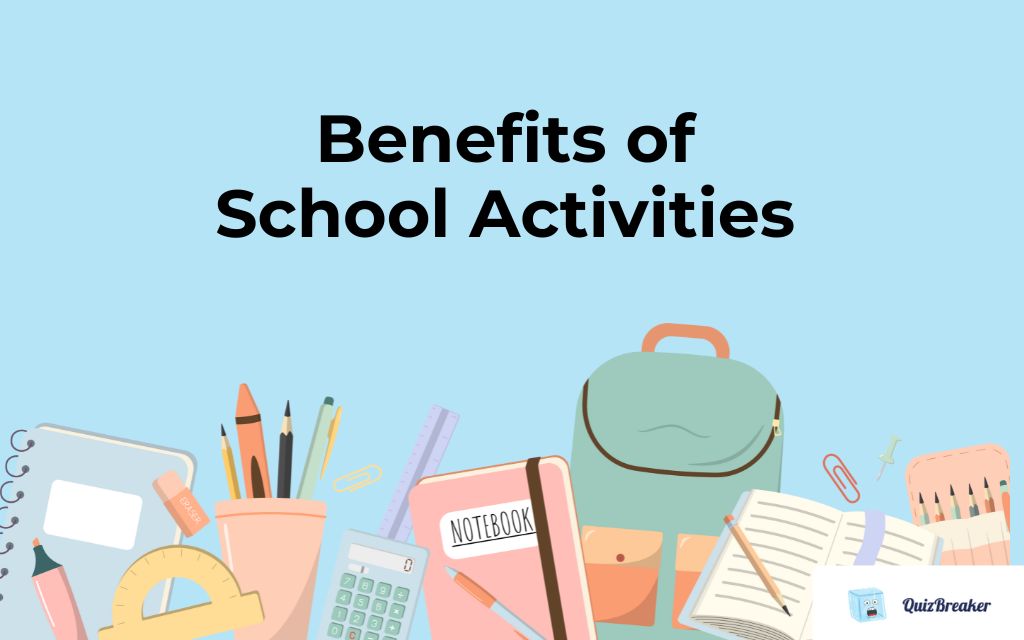
School activities give students the opportunity to engage with one another, and show many of their skills, talents, and capacity in a wide range of settings.
And if you or your students believe such extracurricular activities are unnecessary, we’re here to tell you that they come with many benefits and are worth pursuing.
Below, we discuss the most significant ones.
1) Developing students’ essential life skills
Engaging in school activities allows students to get a taste of real-life skills. For instance, preparing an impromptu speech allows students to work on their public speaking skills, diction, and interaction with the audience.
Other such skills include teamwork, leadership opportunities, prioritization, problem-solving, critical thinking, analytical thinking, interpersonal skills, time management, and so on.
The more students engage in these activities, the more they’ll work on developing these skills.
2) Boosting students’ self-confidence levels
When students take part in fun and versatile activities with their peers, their self-esteem blossoms.
For instance, if they play trivia games, they may realize how much general knowledge they have. This may motivate them to further expand that knowledge, and gives them a much-needed confidence boost.
3) Helping students make (new) friends
Making friends for some students can be a challenge, so having them engage in school activities can significantly help them communicate with like-minded people. Therefore, such activities are especially helpful in larger groups where students don’t really get the chance to talk with all of their peers. Two Truths and a Lie, writing thank you notes, and playing classmates bingo are some awesome activities that can help with this.
Even those who don’t struggle to make friends can use this opportunity to expand their social network and meet new peers. This allows students to explore different perspectives and hang out with people they might not mingle with otherwise.
4) Giving students a break from their daily school routine
When students engage in such organized activities, they get the chance to do something different than what they’re used to, diversify their skills, have fun, and create new favorite memories.
Namely, as much as learning new history information, math equations, and reading assigned literature is important, sometimes these simple school activities may be just what’s needed to make someone’s day and break the monotony in the classroom.
5) Boosting students’ creativity skills
School activities help boost students’ creativity skills. For instance, when students engage in a scavenger hunt activity, although they’re required to follow instructions and a fixed set of tasks, they need to think outside the box too.
Or when they play an escape room, they need to approach the process of solving clues in a creative manner. The same applies to murder mystery games - they need to be open-minded when it comes to interviewing potential suspects, finding “holes” in someone’s alibi, detecting irregularities in someone else’s story, and so on.
And the best part? They get to improve all these skills in a very organic way.
15 School Activities for Teachers and Students
When it comes to choosing school activities for your students, you should strive to find activities that will not only catch your students’ attention, but are also engaging, educational, and dynamic.
And that’s precisely the criteria the school activities outlined below meet.
1) Icebreaker Games
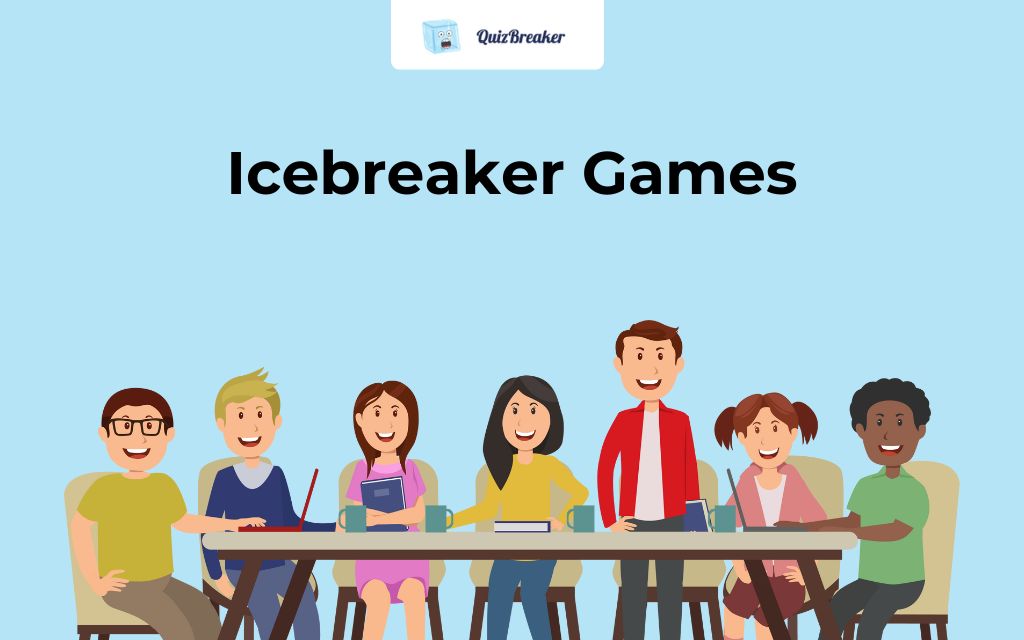
Icebreaker games are great activities to engage your students, create a better classroom community, allow new students to blend in easily, and strengthen trust among classmates.
You can organize icebreaker games for students of all ages, you just need to adjust them accordingly. Here are some examples:
The Toilet Paper Roll Game
For instance, you can try the Toilet Paper Roll game with younger students.
For this game, you need to bring a toilet roll in class, and ask all students to take as many sheets as they want without telling them anything else at this point. Once that’s done, explain to them that each sheet corresponds to a single question their peers will ask them, so they need to answer as many questions as the number of sheets they’ve collected. The game can also be played with candy.
The Time Bomb Name Game
The Time Bomb Name game is another great icebreaker for the beginning of every new school year, as it helps students remember each other’s names. You play the game by asking everyone to form a circle and state their names one by one. Next, you throw a tennis ball at one of the students. They have just two seconds to say another peer’s name and throw the ball to them before it “explodes” (in which case they’re no longer allowed to play and are out of the game). You should continue playing until there’s a single student left.
The Three Things in Common Game
With older students, you can play an icebreaker game such as Three Things in Common. Divide the students into small groups and ask them to come up with three things they have in common. The stranger the things, the better. You can give them some suggestions and prompts if you want, or you might leave everything to them to sort out. After all, groups are done discussing, they share what they discovered and chose with the rest of their classmates.
Icebreaker Questions
Icebreaker questions are a great fit for both younger and older students. You can get as creative as you want and ask “Would You Rather Questions”, “Have You Ever Questions”, “This or That Questions”, “Get To Know You Questions”, or just random icebreaker questions.
Here are some examples of “Would You Rather Questions” to get you started:
-
Would you rather eat a stranger's toenails clippings once a week or have everything smell like rotten eggs?
-
Would you rather be a tissue paper or toilet paper?
-
Would you rather get married to a zombie or give birth to a zombie?
-
Would you rather be insulted by Gordon Ramsay for 10 seconds or receive unlimited text messages from Donald Trump for 10 days?
-
Would you rather go into the past and meet your ancestors or go into the future and meet your great-great-grandchildren?
A little something before you move to the next school activity…
If you’re interested in learning more about icebreaker games and want to access actual icebreaker games and questions, take a look at the following blog posts:
100 Best 'Get To Know You' Questions In Ranking Order
The 10 Best Icebreakers for Large Groups (Instructions)
The 10 Best Icebreakers for Adults (Tried & Tested)
100 Best Ice Breaker Questions In Ranking Order (2025 Update)
Feel free to go with what resonates with you and your students. For instance, the blog post about icebreakers for adults is more suitable for high school students, while the “Get to know you” questions are perfect for the first day of the new school year.
2) Trivia Games
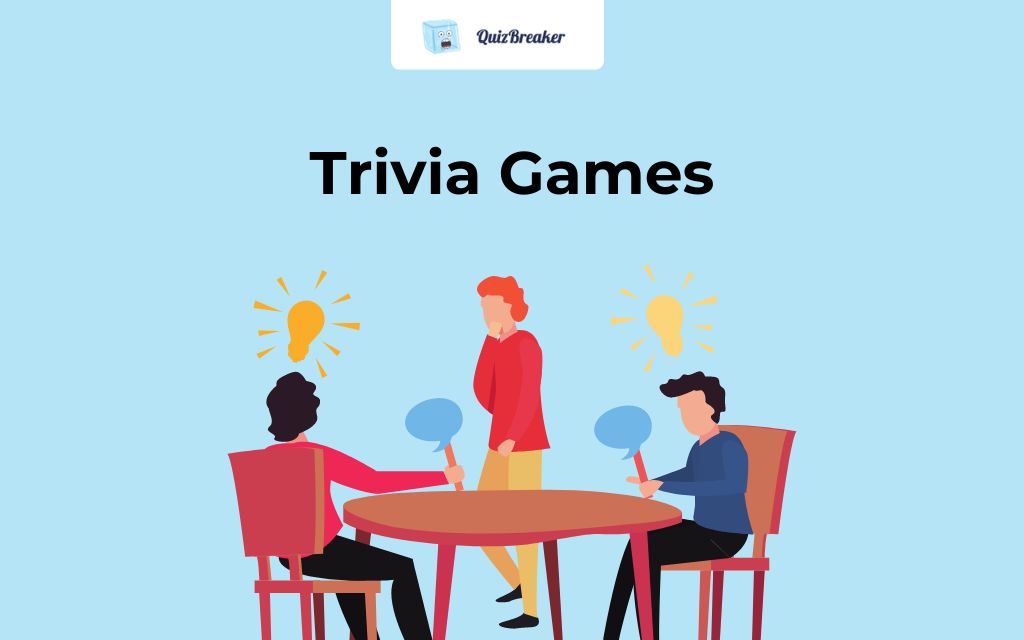
Trivia games are truly some of the best educational activities you can introduce in the classroom. They can be played with a pen and paper or on video conferencing platforms hosted by the teacher.
You can play trivia games both with middle school pupils and high schoolers. You’ll just need to adjust the difficulty level based on who you’re playing with.
You can approach trivia games in two ways - look for ready-made trivia games on the Internet, or devise a game on your own using an app such as Kahoot!. It also depends on whether you’re a fan of traditional trivia games, or you’d like to introduce more digital tools in the mix.
Regardless of which option you choose, the purpose of these games never changes. Put simply, trivia games are a great opportunity for teachers to spark meaningful discussions with their students and encourage collaboration among classmates, as such games are typically played in teams. What’s more, trivia games help students showcase and expand their general knowledge as they’re expected to answer a wide range of questions within a given time limit.
Finally, outline the trivia games’ rules before you start playing; how many points a correct answer brings, how many points a wrong answer costs (if there’s such a thing at all), how much time they have per question, what counts as cheating, and so on. Also, if possible, reward the winning team(s) in some way.
Since trivia games are educational activities, we recommend that you give the winners books, encyclopedias, literary magazines, or other education-related gifts.
A little something before you move to the next school activity…
If trivia questions sound like something you might want to try out in your classroom, we recommend checking out TriviaNerd and enjoying an ever-growing library of amusing trivia questions in a wide range of categories, such as food and drinks, pop culture, tv shows, movies, celebrities, general knowledge, high school sports, geography, history, art, decades, lifestyle, music, and many more.
Moreover, every category has its own subcategories (it all depends on how specific you want to get with the trivia questions). For instance, if you click on the Movies category, you’ll notice a whole collection of movie trivia questions you can engage in divided into groups such as Animation, All Things Disney, 1050s Films, Black Panther, Classic Movies, Films Released in the 1930s-1950s, Avatar, and so on.
Finally, if you enjoy a much more random approach to trivia questions, check out the Random Trivia Generator (a free tool) and have fun with your students.
3) Escape Games
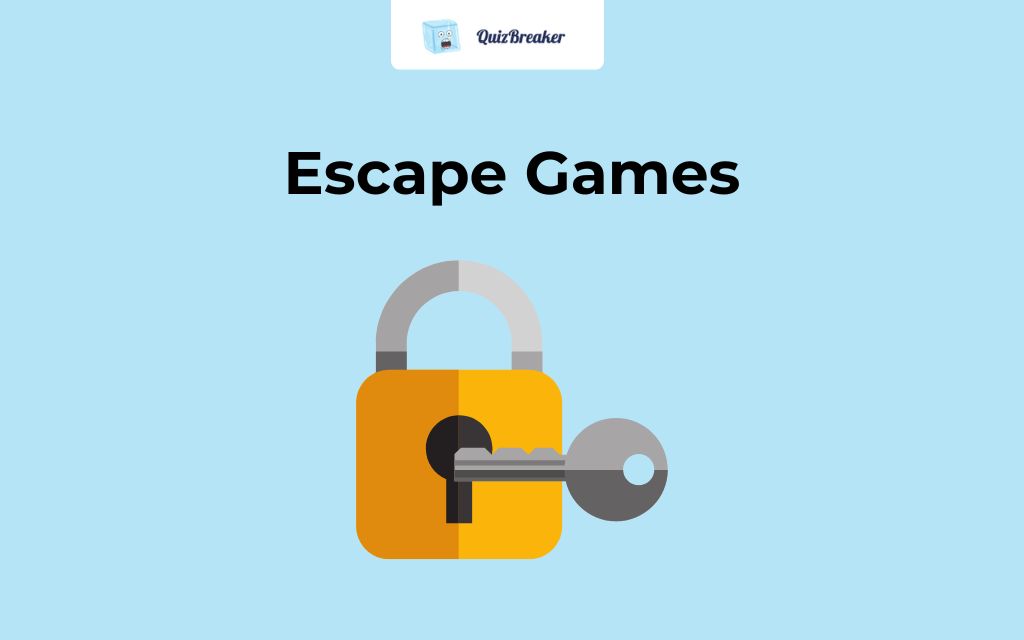
Escape games are games where people are required to follow clues, face challenges, link meaningful ideas, and collaborate with their group, so they can find a way to escape the room. The games are also known as exit games or escape rooms, and they can be played both in-person and online.
Such games are usually great for older students - preferably high school students or higher levels, as they come with complex challenges and require problem-solving skills that elementary school kids may still lack (not to mention that young people may find the concept of escaping a room a bit frightening).
With that said, there are certain escape games created specifically for younger children, so if this is something you believe your school group may resonate with, by all means, go for it.
What’s more, if you decide to create an escape game yourself - you can make it as simple or as complicated as you want.
Here’s what you can do:
-
Think of a theme. For instance, you might transform the classroom (the escape room) into a room from another decade, a submarine, or come up with something that the majority of your students approve of.
-
Think about the potential tasks and challenges. Bring some boxes and lockers to the classroom if it’s necessary and make them suit the escape room vibes. Place the tasks and the challenges there. You can use math, chemistry, languages, crosswords, reading comprehension, and other academic activities with multiple answers, and so on. With that said, ensure the first several tasks are fairly simple and straightforward. This will help your students feel more confident in their skills and they can progress toward the more complex tasks with greater self-esteem.
-
Write down the game’s instructions. Next, set the game’s rules and the order of the tasks and challenges. Another important thing is to decide whether the whole class will be playing as one group, or if it’s better to divide the students into several groups and give each group a go. We say go for the former if you have a smaller class, and for the latter, if your entire class consists of more than 10 students.
-
Enjoy the actual game. When the day comes, remember to enjoy the escape room with your high school students. Help them where that’s possible and encourage them if they feel like giving up.
-
Celebrate your students’ escape room success. Give some rewards to the winning team(s) and bring some snacks and drinks to celebrate their “escaping.” You may also recognize some other group or individual achievements, such as leadership opportunities, patience, outstanding problem-solving skills, and so on.
-
Take some time to reflect upon the overall experience. And do so while it’s still fresh in everyone’s memory so they can recall as many details as possible. What worked for everyone? What didn’t? Were the tasks very simple? Perhaps slightly more complicated than what they expected them to be? This will help you plan escape room events way easier in the future.
Finally, feel free to ask your students what they’d like to see as part of the escape room experience. Listen to their suggestions and ideas and if they sound reasonable and feasible, implement them as closely as you can.
A little something before you move to the next school activity…
It’s hard to predict whether students will be required to resort to distance learning in the future as was the case during the COVID-19 pandemic, however, you don’t need to wait for such scenarios to try out a digital escape room with your students.
And since there’s such a versatile choice when it comes to online escape rooms, here are some articles where you can find some of the best online escape room games, ranging from self-hosted to fully-hosted escape room experiences with games masters: 20 Best Online Escape Rooms (Reviewed & Ranked).
4) Murder Mystery Games
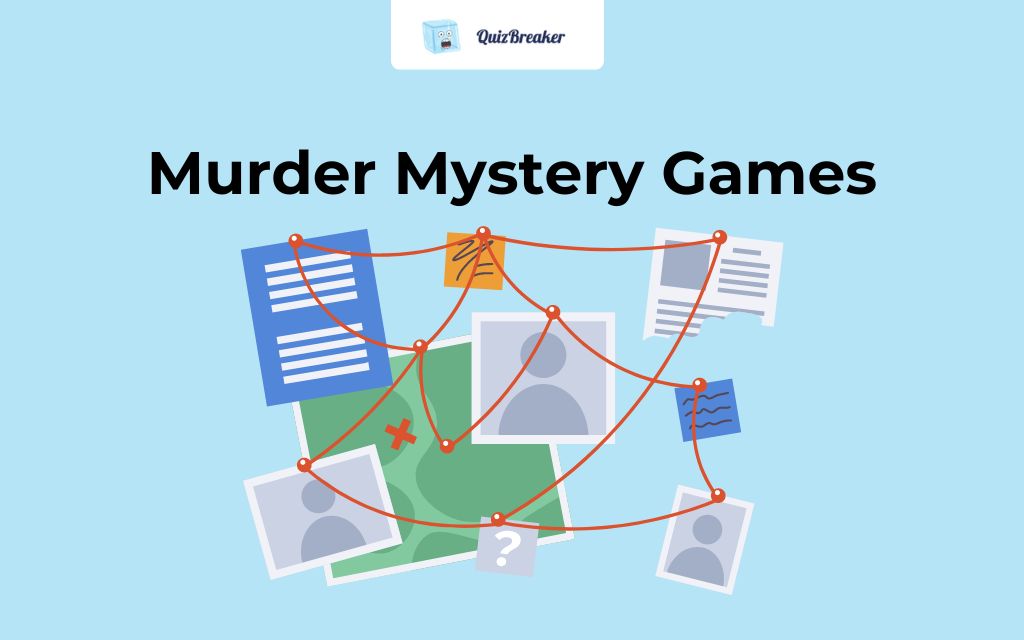
Murder mystery games are entertaining games where players are expected to discover the murderer among them. Each murder mystery game has a different context, but the overall premise is the same - detect suspects, follow the clues, check for alibis, and identify the murderer.
Moreover, when you play murder mystery games, there’s an option to follow an already written script that includes character background, specific details and information, and there’s little to no deviation from that script during the game duration. Alternatively, there are also games that allow for more spontaneity. This means players are encouraged to come up with their own ideas, and make decisions on behalf of their characters.
You can either play ready-made murder mystery games or devise one specifically for your class. Here are some great ready-made murder mystery games to try out:
With that said, regardless of which option you pick, the steps for playing a murder mystery game in the classroom are as follows:
-
Pick a murder mystery game. Choose a context that most students will resonate with. You can be as creative as you wish with this.
-
Familiarize the students with their characters and the game instructions. Give each student a card relevant to their character, write down some clues, and allow them to grasp all the necessary information before they can start playing. Also, allow students to ask any questions about their character that they may have at this point.
-
Go over some key vocabulary related to the game. If you’re playing the game with younger students, explain concepts such as alibi, clues, and motive in a detailed manner. Make sure everyone’s comfortable with the meanings. If you’re playing with high school students, you can be brief about this.
-
Divide the students into groups (please note each murder mystery game has a different approach, so it could be that some aren’t played in groups).
-
Encourage students to play the role they have. Students need to ask questions such as “Where were you when the murder happened?”, “Who was with you?”, “Can anyone confirm this?”, “How well do you know the victim?”, “When was the last time you had any contact with the victim?”, and so on. Let them know they need to listen to their classmates’ answers carefully so they can look for inconsistencies and identify those who are lying.
-
Allow the students to work out their clues, gather information, and go through everything they have. Do help them when that’s necessary, but allow them to take the lead and arrive at a conclusion on their own.
-
Once you’re done playing the game, discuss the murder mystery event and how students feel about it.
A little something before you move to the next school activity...
If you do end up incorporating such student activities within the classroom, make sure to gather feedback from your students. That’s key to ensuring:
-
There’s always a plethora of fun activities in the classroom the majority of students approve of.
-
Students know you pay attention to the school activities they’re exposed to.
-
You stimulate their social skills by asking them to engage with their teacher(s).
-
You create a pleasant school community.
-
You care about their mental health.
-
You don’t just follow the classroom rules and classroom district regulations blindly, but you’re genuinely interested in what your students have to say.
5) Two Truths and a Lie
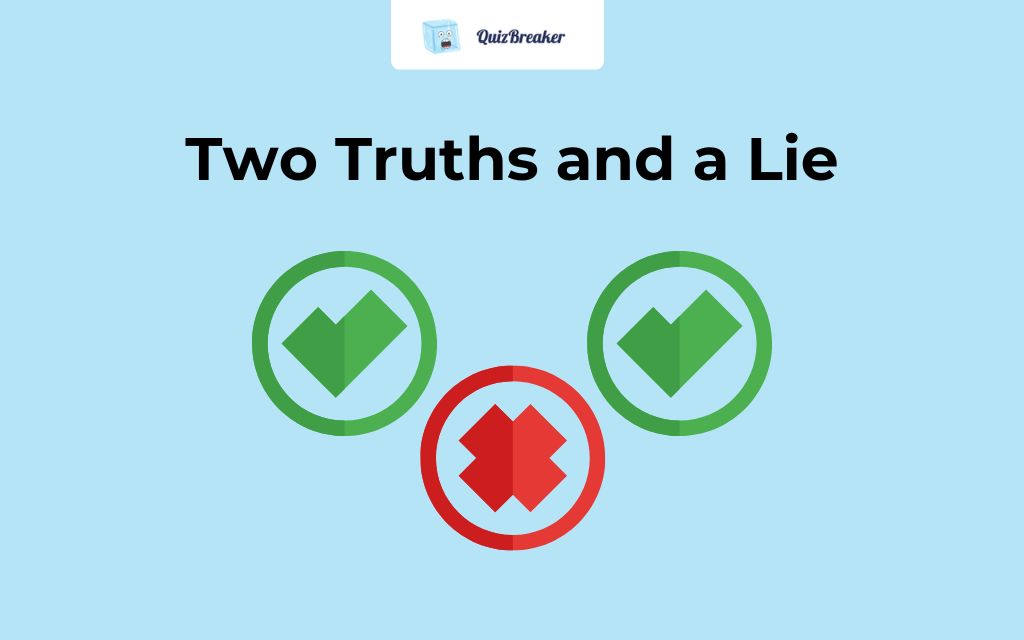
Two Truths and a Lie is a fun way to start the school day, help students work on their social skills, allow new classmates to meet their peers and teachers, entertain high school students, and create a loving classroom community.
The game is simple, yet effective. In fact, practice has shown time and time again that it’s even better than most co-curricular activities out there.
Through this game, people get to learn some fun facts about others. The game’s rules are really simple: every student is meant to write down three statements about themselves - two should be true, and one is supposed to be a lie. Afterward, all classmates take turns and share their sentences with the rest of the people in the classroom, and the others are meant to guess which one’s the lie.
With that said, although Two Truths and a Lie is fairly simple to organize and play, make sure to explain to your students that they shouldn’t make their false sentences really obvious. Put simply, they should challenge their classmates to guess what’s true about them and what isn’t.
That’s what makes the game so entertaining!
A little something before you move to the next school activity…
If you want to make the game a bit more competitive for the students, introduce points. For instance, each time a kid identifies someone’s statement as a lie, they’re awarded one point. When they’re wrong, they may lose a point. In the end, the student with the most point is the game’s winner.
6) Class Time Capsule
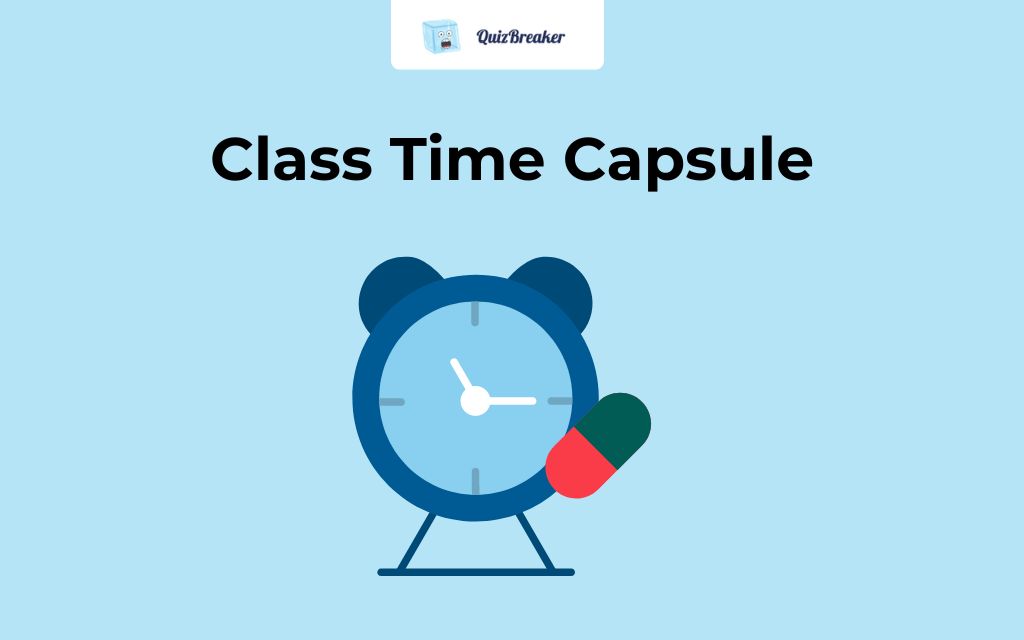
the Class Time Capsule is an awesome activity that you can do with your middle school pupils on the first school day to ease their transition back into their school lives.
First and foremost, explain to them what a time capsule is. Tell them it’s a container that holds things from the present, meant to be opened in the future. Let them know they’ll open their time capsule at the end of the school year, and they can see how much things have changed, that is, how much they have changed.
Once everyone’s done, take all of their time capsules and put them in a locker or someone on the shelves. Make sure they don’t touch them throughout the year. Remember to open them on the final day of school.
Just imagine everyone’s faces when they get to open their own time capsule and see what they drew/wrote.
A little something before you move to the next school activity…
Here are some ideas of what your pupils can include in their own time capsules:
-
About me template - they should write down information such as height, weight, hair length, how many teeth they’ve lost, and so on. Some details, especially the height bit, always tend to be surprising as kids grow a lot, so prepare to be amused when you take a look at their faces at the end of the year once they open their time capsule.
-
A list of their goals - kids should write a few main goals for the whole year. This is a great way to teach them from an early age to plan and later reflect upon their goals and planning process.
-
A selfie - kids should take a photo of themselves and put it in the time capsule. It’s a great visual way for them to compare how they looked at the beginning of the new school year vs. the end.
-
“When I grow up…” statement - kids should note down what they’d like to be when they grow up and why. It’d be interesting to see how much their interests, wishes, and ambitions have changed over the course of one year.
-
Handprint - this will show them how much their hand has grown.
-
Anything else. Feel free to add other templates or items you think are useful for the children’s time capsule.
7) Tall Thomas
.jpg)
“Tall Thomas” is a great activity for young people, preferably elementary school pupils, which can be played at the start of the new school year so students can get to know each other better.
In this activity, you need to ask the pupils to come up with an adjective that best describes them. However, it shouldn’t be any adjective they can think of - the adjective should start with the first letter of the pupil’s name.
For instance, if a pupil’s name is Thomas, they can think of the adjective “tall”. Or if someone’s called Bobby, they can say the adjective “blonde”.
With that said, ensure pupils come up with an adjective that truly describes them - in other words, if Bobby has blonde hair, the adjective “blonde” is fine.
To do the activity, ask the children to stand in a circle and as they say their names, ask the rest of the group to repeat the name the last kid had said. Asking pupils to memorize all names adds a skill-testing aspect to the overall activity.
You can ask children randomly to repeat the names, or you can have the next student repeat the previous kid’s name before saying their own.
All in all, keep the activity fun and simple.
A little something before you move to the next school activity…
We suggest that you start the activity by joining the children's circle first and stating your own name and chosen adjective. That way, you’ll break the ice, show the pupils what they need to do, and help the overall social-emotional learning process - by joining their circle and doing the activity yourself, you make the children feel like you belong in the circle there with them.
8) Classroom Scavenger Hunt
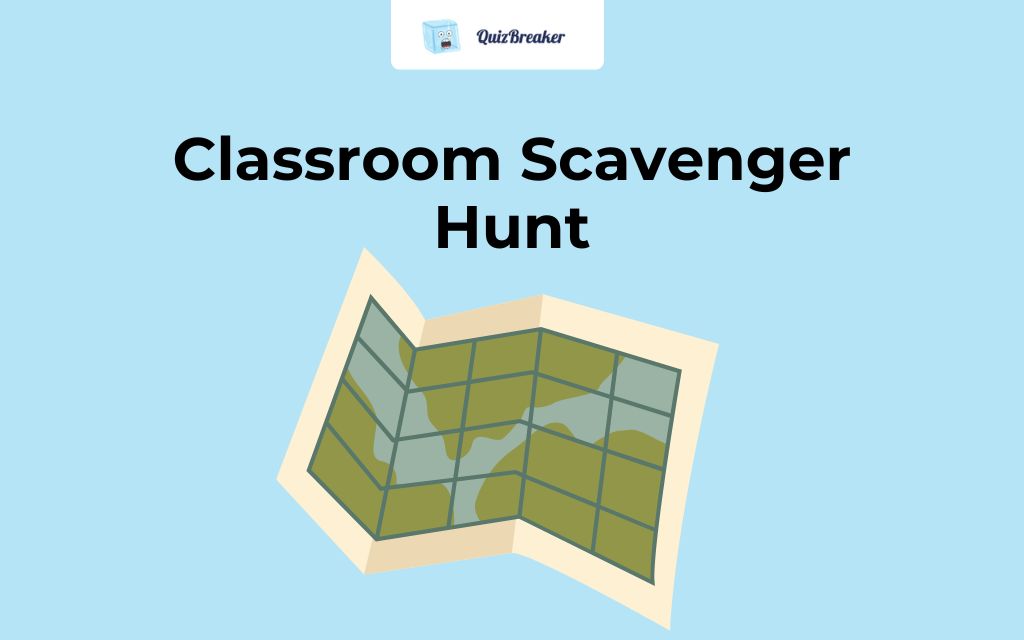
A scavenger hunt is a fun activity that has people go around gathering various different items, doing challenges, and performing a wide range of activities from a list.
The game is played in a wide range of formats and can be applied in various different contexts. Classroom Scavenger Hunt is no exception, and it’s generally suitable for older students (you wouldn’t do this with younger students or first graders in elementary school, for instance).
Such high school activities are meant to be a fun icebreaker that helps classmates bond in a deeper way while moving around and being active. For instance, students may be required to take a selfie, find their favorite school item, bring a book or literary magazine from the school library to the classroom so that they can earn points, and so on.
Here’s what the game is supposed to look like:
Step 1
Prepare a list with all the challenges, tasks, and items the students are meant to get. While creating the list, take into account that the scavenger hunt takes place in the school, so all the items they’re supposed to find must be on the school premises. After carefully creating the list, assign points to each task/challenge - make sure to place more points for the more demanding tasks and challenges.
Step 2
Set the rules and guidelines, and inform your students. Here are a few suggestions to get you started: give your students 15-20 minutes to complete a 20-entry list; if they’re meant to take photos, don’t accept images downloaded from the Internet (highlight that they need to be original ones); if someone cheats they can’t proceed to play the game; and so on. Also, decide whether you’ll let each student play individually or divide them into groups.
Step 3
Begin the Scavenger Hunt game. Use a stopwatch and urge your students to pay attention to the time to make sure they’re back within the necessary timeframe. Moreover, tell them that if they have any problems or unclear matters, they can return to the classroom at any time and ask you anything.
Step 4
Once the students are back, take the necessary materials (everything they brought with them, took as part of a challenge, wrote down, and so on). If photos or videos were requested as part of the tasks, they can show you those on their phones.
Step 5
Take a look at everyone’s submissions. Calculate the points and announce the winner(s). If there are any tied scores among classmates, have some tiebreakers as a backup. Once you've settled on the winner(s), give them rewards. It can be a free book, a copy of the school’s literary magazine, chess club coupons, taking part in after-school activities/ co-curricular activities of their choice, picking which sports teams they’d like to join, and so on.
All in all, the whole point of this activity is to help students deal with a wide range of challenges, boost their competitive spirits, and trigger their creativity.
A little something before you move to the next school activity…
Whenever you plan such student activities, make sure all classmates are respectful toward everyone within the school district premises and aren’t breaking any rules/laws. Also, if you decide that a specific item/challenge/task may be slightly dangerous, don’t include it. At no point should any requirements of the game pose a danger to your students’ overall well-being.
Or if you find a particular challenge to be tricky - for instance, asking a teacher to take a selfie with the students (and you don’t know how certain teachers may feel about it), again, don’t include it.
The whole point of the scavenger hunt is for the students to have fun, not potentially create problems.
9) Assign Impromptu Speeches
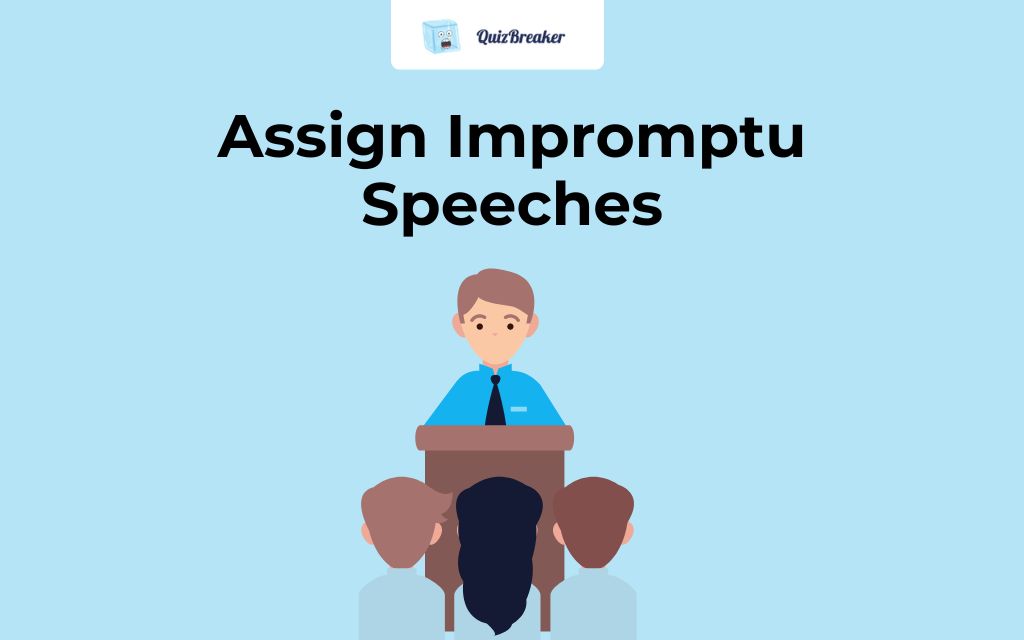
Impromptu speeches are speeches people are required to make on the spot (or they have very little time to prepare for them).
Impromptu speeches are amazing, especially as part of regular high school activities because they improve speaking and writing skills. However, you can prepare such activities with middle school students too - the themes and the overall approach may differ, though.
For instance, if you’re assigning impromptu speeches to middle school pupils, give suggestions for themes like their summer/winter holiday, favorite singers/actors/movies/songs/TV shows, video games, friends, sports, and so on.
If you teach high schoolers, allow them to discuss more complex matters, such as choosing a university, choosing a career path, building relationships with other people, their favorite memory from when they were growing up, the challenges they face as teenagers, and so on.
Giving instructions
After you assign the theme or provide students with several they can choose from, give them a few moments before they’re expected to begin with their speeches. They can grab a pen and a piece of paper and make a brief plan about what they’re going to talk about.
Explain that they need to have an introductory sentence, elaborate on the topic by giving arguments and examples, and work their way toward the ending sentence. Put simply, their speech, although impromptu, needs to be structured and cohesive.
Here are some other instructions you can give them:
-
Students shouldn’t memorize their notes in detail, rather remember significant points and follow a basic outline.
-
Students should concentrate on their diction and tone. They shouldn’t talk too fast, and need to maintain eye contact with the audience.
-
Students should contemplate questions received from you or the other students,
Providing feedback
You should also create a handout that students need to fill out after a classmate delivers a speech so that they can give them feedback. This feedback should include both the positives and the negatives of their presentations.
Here are some possible questions you can include in the handout:
-
Was the overall message clear?
-
On a scale of 1-10 (1 being the lowest and 10 the highest), how interesting was the speech?
-
On a scale of 1-10 (1 being the lowest and 10 the highest), how engaged was the audience?
-
On a scale of 1-10 (1 being the lowest and 10 the highest), how organized were the person’s ideas?
-
What can this person do better the next time they present their speech?
Finally, make sure to make things fun for your students and not have them stress over these impromptu speeches. Perhaps a good idea would be for you to break the ice and deliver a speech yourself before others in the class have a go.
A little something before you move to the next school activity…
Some students may interpret such impromptu speeches as a cruel trick through which teachers are trying to catch unprepared students. That’s why we suggest that you explain to your students what the whole purpose behind such speeches is.
For example, tell them that these assignments help them develop public speaking/communication skills. Also, it helps them express their views, think critically about certain topics, and manage to complete a task under pressure (as they don’t really have a lot of time to prepare). This approach will ultimately help them build confidence and prepare them for life in general.
10) Play Outdoor Games
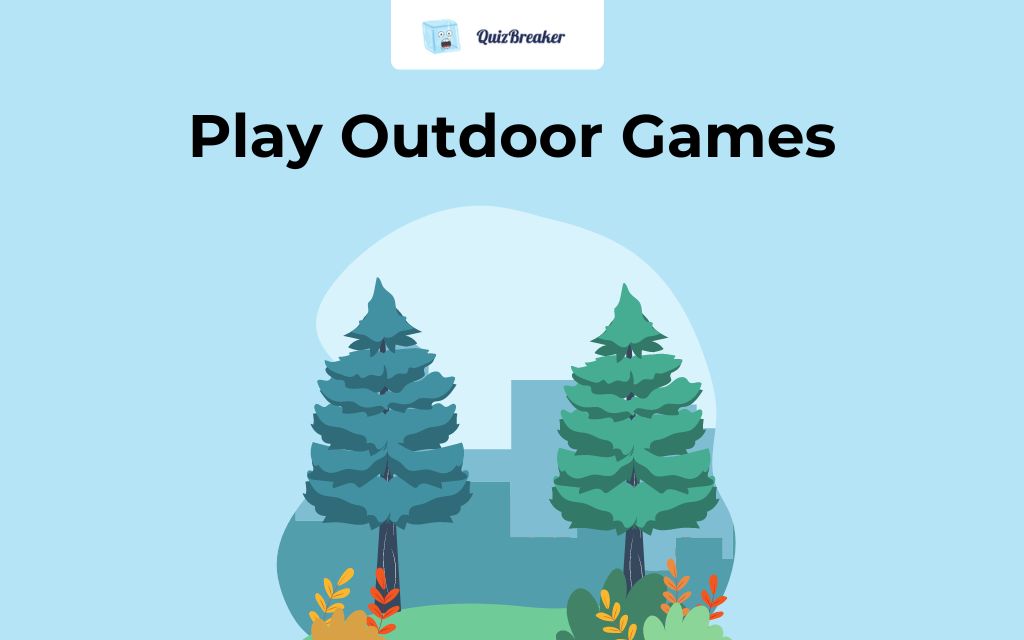
The main school activities may take place within the classroom, however, engaging in outdoor activities is as important.
Making sure your pupils get regular physical activity is key, especially in today’s digital era when they seem to be glued to their phones.
Playing outdoor games is more suitable for younger students, and there’s a plethora of games you can choose from. Here are several suggestions:
-
Simon Says;
-
Red Light, Green Light;
-
Mother, May I?;
-
TV Tag;
-
Freeze Dance
-
Tug of War
-
Prisoner of War
-
Water Balloon Toss
-
Nature Scavenger Hunt
-
Hopscotch, and others.
A little something before you move to the next school activity…
You can always ask your pupils to tell you some outdoor games they enjoy playing. This way, you’ll be sure they’ll like the games you pick for them. Plus, it will keep things versatile, as playing the same outdoor games time and time again may become boring for some.
11) Hold a Spelling Bee
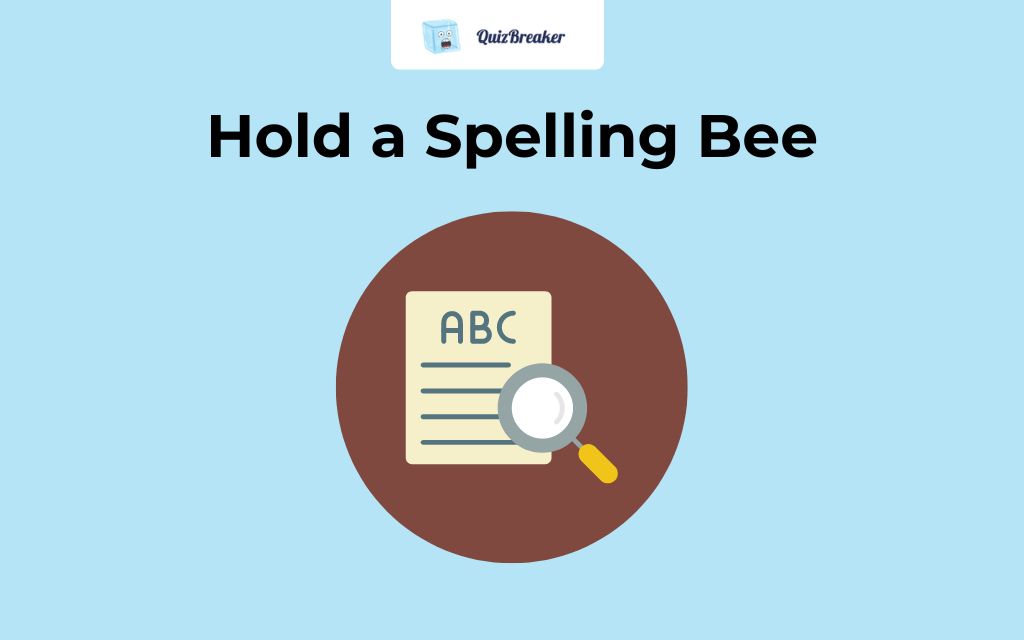
Spelling Bee competitions are organized activities suitable for elementary school children, academic clubs, and even higher grade level students. They may take place within classes, or they might be organized as separate school events.
It all depends on who’s competing - is it one class, several grades, or even several schools? Knowing this helps you plan the actual event. Since the last one is too big of an endeavor, let’s take the first two as examples.
In this case, you need to reserve a separate classroom in a time slot that works well for everyone involved both in the competition and organization (teachers, children, parent volunteers, administrators, judges, and so on). Make sure everyone’s notified of the date well in advance.
Decide what word lists you’ll use and inform the spellers. Also, you’re meant to be practicing these lists with them, so they’ll know what to expect.
Come up with spelling bee rules. Here you should tackle matters such as in what order the students are expected to spell, where the spellers sit in the classroom, whether they’re allowed to communicate with others during the competition or not, how much time the spellers have to complete a given word, and so on. Consider potential issues such as homophones. For instance, if spellers need to spell the word “waste”, clarify it in the following way: Coming to the party was a waste of time, so that spellers don’t confuse it with “waist”. Don’t forget to send out written copies of the rules to the spellers, parents, judges, and others.
Make name tags for all the spellers and give them on the day of the competition, especially if you're running events for inter-school districts competitions.
Moreover, decide on the prizes. Give spellers certificates, medals, trophies, gift cards, and/or goody bags.
Once the day comes, double-check the seating arrangement, the word list, name tags, and so on. Welcome everyone, and after everyone’s ready, you can begin.
Get your student government body involved by having them help run spelling bee programs. Getting the student body involved will also help them improve their planning and organization skills. You can turn the school engagement into extra credit so they are incentivized for their help.
When you finish with the competition, thank everyone who helped organize it either by leaving handwritten notes to the school staff, or sending emails to the parent volunteers.
A little something before you move to the next school activity…
Spelling bee competitions may be stressful for participating students, and what better way to support them than by having their peers rooting for them? So, remind your students to cheer for their classmates who are competing. It’s up to them to create a welcoming atmosphere and encourage their peers.
12) Write Thank You Notes

You can write thank you notes for many reasons in the classroom. Students can learn to express gratitude both for big and small things to all their classmates. For instance, they can thank a peer for being helpful, for being a good friend, for borrowing a jacket when they were cold, for helping them understand a new math concept, and anything else.
This is a great activity for elementary school pupils, so encourage them to engage in it throughout the whole year. Here are some tips your pupils should consider when writing their thank you notes:
-
Make your note recipient feel special by using a pen in their favorite color, a sticker that will make them happy, eye-catching paper, and so on.
-
Personalize each thank you note you write by referring to your classmates by their (nick)names.
-
Be as specific as possible by stating exactly what you’re thanking them for, and include a brief, but meaningful sentence from the heart.
-
Try to be prompt with your notes by thanking the recipient for something that happened recently.
-
Use neat handwriting.
-
Turn this note-writing into a habit you’ll nourish throughout the whole school year (and even afterward).
-
Be proud of the thank you notes you’ll write.
-
Have fun!
A little something before you move to the next school activity…
We’re quite fond of this activity because it helps the overall social-emotional process in the classroom (pupils both communicate with peers, but at the same time reflect upon their feelings of gratitude toward a specific classmate).
Also, it helps create a classroom community where pupils show respect for each other. It promotes kindness and appreciation too.
Finally, receiving a thank you note may be just what makes a pupil’s day. Plus, there’s something quite special about handwritten thank you notes.
13) Write a Letter to Next Year's Students
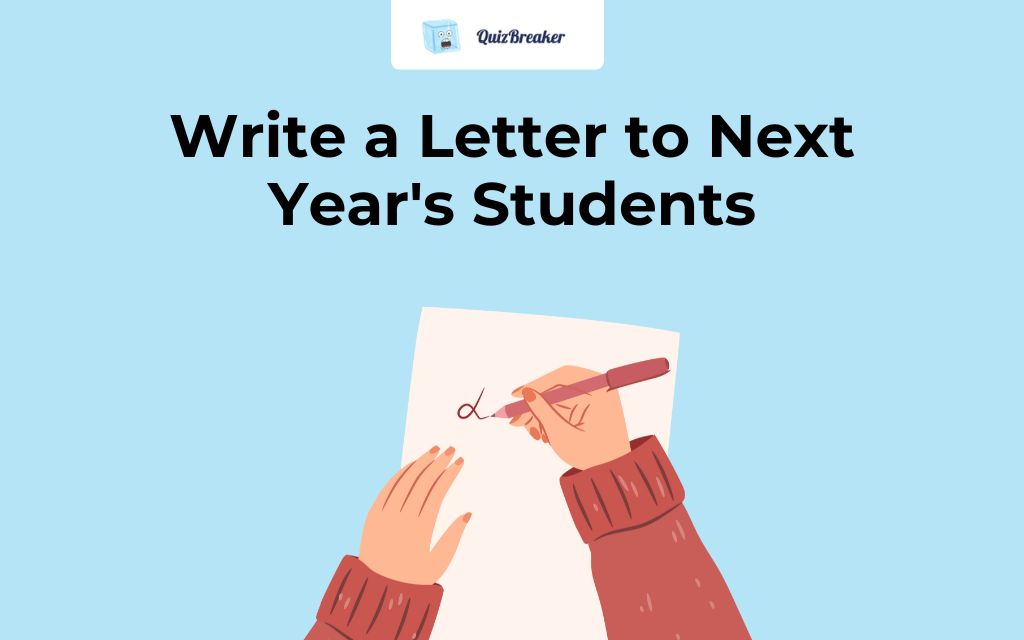
Preparing for the upcoming school year and welcoming new students can be done in many ways, but asking your older students to reflect upon your course is probably one of the best.
This activity is great for new teachers, older students, students who have yet to write college applications, and so on.
Moreover, this is an activity that benefits both teachers and students - teachers can see how students perceive their course, and the students can contemplate their experience with this specific school subject and the teacher. Also, new students can get informed insights into how they can make the most of the upcoming school year and succeed with greater ease.
How should you approach this assignment then?
A guide to writing a letter to new students
First of all, organize a pre-writing discussion and explain what needs to be done. This brainstorming session should help students write the letter by following some guidelines. For instance, you can outline some ideas with various question prompts, such as:
-
What school material should the students have for this subject?
-
What should they be informed about regarding the teacher’s expectations?
-
What do they need to do to get good grades for this course?
-
What are some things they shouldn’t do during classes?
-
What kind of content should they expect to learn?
-
What are some things you truly liked about this course?
-
What are some things you disliked about the course?
-
What would you change to make this course even better if it were up to you?
-
What stood out for you during the classes?
-
What kind of student activities or goal-setting prompts would you have loved to see more of?
-
Has the course affected your mental health in any way?
-
What are some of your favorite memories you connect with this course?
Once you’ve discussed such matters with your students, they’re ready to start writing their letters to the new students who are yet to take this course.
A little something before you move to the next school activity…
Insist that the students write with a pen and not type on their phones/computers and then email the letter to you. There’s a big difference between writing and typing something.
The process of writing something on paper provides an opportunity for a more critical thinking approach, better conceptual understanding, and a stronger emotional connection to what’s being written.
14) List what you’ve learned from A to Z
.jpg)
Create a worksheet and allow students to write down what they learned during this course this school year. Make sure they name one thing for each letter of the alphabet. Also, the “thing” they name is supposed to match the specific letter from the alphabet - for instance, if they took a course in Biology and learned new information about the anatomy of the human abdomen, they should write this down under the letter “A”.
If you’re trying to encourage teamwork and make your students even more productive, group them so they can collaborate.
This activity is more suitable for younger kids. It’s not something that high school students would resonate with.
A little something before you move to the next school activity…
If you do decide to try this activity with much younger kids and you’re afraid it’d be difficult for them to fill in the worksheets properly, ask them to draw an image next to each letter instead of writing things down. This way, you’ll still encourage them to think about the things they learned throughout the school year, and also allow them to express themselves creatively.
15) Play Classmates Bingo
.jpg)
Classmates Bingo is a great activity for the beginning of every new school year. It’s mostly suitable for younger students, although, if older students are up for it, why not give them a chance to play it too?
If you want a ready-made bingo worksheet, check out what websites such as Teachers Pay Teachers have to offer. This specific activity includes 20 different bingo cards. Some of the cards read “whose favorite season is winter”, “whose favorite subject is math”, “who has a pet bird”, “has been to a different country”, and so on.
Students are supposed to walk around, and once they find a classmate that fits a bingo box, they need to write that kid’s name on the line.
The first person to fill all the boxes yells “Bingo”. You can choose whether they need to get a full horizontal line of words or yell the word, or they may need to get a vertical line. It all depends on how long you want the bingo game to last.
If you want to involve your students in the bingo game, ask them at the beginning what they think a completed game looks like. Consider their suggestions and see whether they resonate with your understanding of the task.
Finally, if you dislike ready-made templates like the ones provided by Teachers pay Teachers, you can always create your own bingo cards. In fact, you might adjust the bingo cards based on what you know about the children (this applies if you play this game with kids you already know, if they’re new students, it’d be kind of difficult to do so).
A little something before you move to the next school activity…
Once you’re done playing the game and you’ve given the winner(s) their prize(s), you can invite pupils for reflection. In essence, you can ask them to introduce another peer by sharing an interesting trait or thing they’ve learned about someone else.
This is great for their social-emotional learning process, and it allows for deeper bonds to be developed among classmates.
Frequently Asked Questions
Do I need parents’ permission to do any of these games?
While making sure you have parents’ permission for any type of school activity is great, doing so may prove to be more challenging in practice.
Namely, most of these activities are played during the school day and may be part of a teacher’s lesson plan. And teachers don’t consult parents about each activity they do with their kids at school (this applies both to middle school and high school students).
That being said, there are certain school activities that require you to get in touch with the students’ parents. For example, if you organize a spelling bee competition, the parents should be informed well in advance that their kid might take part in a competition. Of course, they’ll probably end up being invited anyway, however, it’s important to inform them first about the possibility and have them tell you they approve of it.
How often should we do school activities?
No one can tell you exactly how often you should do school activities with your students/pupils.
You may find out that certain groups and grades resonate more with such school activities - others not so much. Also, it depends on the type of activity.
For instance, opting for an activity such as the thank you notes means the pupils are committed to writing such notes for the whole year. And you can’t say for sure how many notes they’ll end up writing. It’s a freestyle activity.
On the other hand, if you decide to do the time capsule or the writing-a-letter-to-next-year-students activity, the students will need to do this only once.
This is why combining school activities is important. Namely, you should pick some activities that are done just once - usually at the beginning of the school, and others they can engage in throughout the whole year.
Also, you may need to take some objective factors into consideration. For instance, during winter months, you may not be able to organize outdoor games at all. However, in spring or toward the end of the school year, you can plan such school activities much more often.
Finally, ask your students directly how often they enjoy engaging in such activities.
Where can I get resources for these student activities?
Finding resources for these student activities isn’t difficult.
First and foremost, you can always rely on Google. There’s a plethora of worksheets, templates, and other samples you can use for activities such as classmates bingo.
Also, you can always check out websites that specialize in specific activities, such as escape rooms, murder mystery games, or trivia games (we already provided you with some useful links).
Alternatively, you can create some resources yourself. For instance, you can devise a template for the Scavenger Hunt game and put items and challenges that personally relate to a specific class. Or if you hold a spelling bee competition, make sure to include word lists that go hand in hand with what the students have learned so far. Feel free to write your own icebreaker questions too.
The more creative you are, the more successful the student activities,
Finally, for some activities, you don’t need any specific resources or complex worksheets, such as for writing thank you notes, writing a letter to next year’s students, assigning impromptu speeches, Tall Thomas, Two Truths and a Lie, and so on. These school activities revolve around a student’s creativity and their own resourcefulness.
Final Words
So there you have it!
15 entertaining school activities for teachers and students.
You can try them, combine them, analyze them, or simply go back to them when you feel like choosing a new one.
Let us know which school activities are your favorite, or if there are any additional ones we should add to our list.
